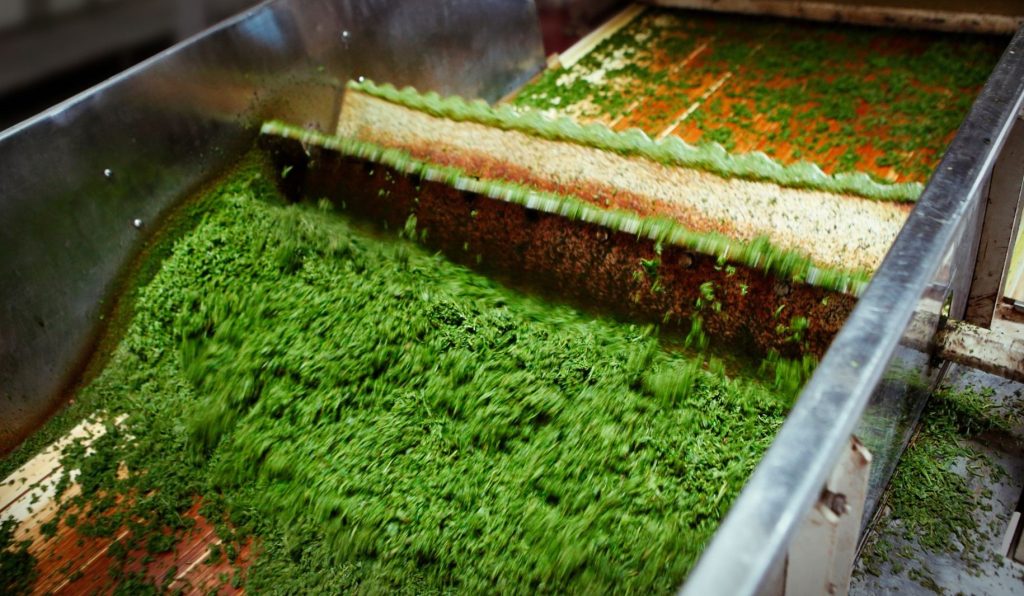Tea Plant Complete Cultivation Guide

This post is also available in:
This post is also available in:
![]() Español (Spanish)
Español (Spanish) ![]() Français (French)
Français (French) ![]() Deutsch (German)
Deutsch (German) ![]() हिन्दी (Hindi)
हिन्दी (Hindi) ![]() Português (Portuguese (Brazil))
Português (Portuguese (Brazil))
How to grow tea – Commercial tea cultivation from seeding to harvesting and processing
General Information about tea
Tea (Camellia sinensis(L.) O. Ktze ) is one of the world’s most beloved beverages, with a rich history that spans centuries and continents. From its origins in ancient China to its spread to other parts of Asia, Europe, and the Americas, tea has played a vital role in many cultures and societies.
The tea leaves are oblong or elliptic, with an acute apex and cuneate base; the leaf surface is glossy, the lower surface of the leaf is glabrous or just beginning to be pilose, and the leaf edge is serrated. The flowers are white with broadly ovate petals; flowering usually occurs from October to February of the following year (1).
Tea is originally distributed in southwest China; cultivation is widespread. Mountains, flatlands, and basins can be grown, but it is mainly grown in the hills and mountains. The temperature that is generally considered suitable for the economic cultivation of tea is above an annual average of 13℃; from the situation of tea water requirements, the areas suitable for tea planting require an annual rainfall of more than 1000 mm. Tea is sensitive to the pH of the soil, generally with a pH value of 4.0-6.5 as appropriate (1).
Health benefits of tea
Tea beverages made from tea leaves are one of the top three beverages in the world. Tea contains catechins, cholesterol, caffeine, inositol, folic acid, pantothenic acid, and other substances that have functions such as being refreshing, digestive, antioxidant, and lowering blood pressure, making it a natural health drink. Here are some beneficial ingredients and the value of tea:
- Tea polyphenols are the most abundant class of soluble components in tea. They are also the most important substance for tea to exert its health benefits, which has many effects such as antioxidant (eliminating oxygen free radicals), anti-inflammatory, reducing the incidence of cardiovascular disease, lowering blood lipids, reducing body fat formation, antibacterial, and changing the ecology of intestinal flora. Studies have shown that after drinking a cup of tea for half an hour, the antioxidant capacity (the ability to fight oxygen free radicals) in human blood can increase by 41% to 48% and last for an hour and a half in a high-level state.
- Tea pigments mainly include chlorophyll and beta-carotene, which delay aging as well as beauty.
- Theanine can improve brain function and enhance memory and learning ability.
- Tea polysaccharides are a complex mixture of components. Tea polysaccharides have anti-radiation, which will help people to increase the number of white blood cells, improve immunity, and lower blood sugar.
- The main effect of Υ-aminobutyric acid is to dilate blood vessels to lower blood pressure, so it can assist in treating hypertension.
- Pyrroloquinoline quinone – A team of researchers from Nagoya University in Japan recently discovered that the pyrroloquinoline quinone component of tea could slow down aging and extend life (2).
Current status of tea cultivation
In terms of tea acreage, global tea acreage has grown steadily in recent years as the global tea industry has continued to develop. As an important part of global agriculture, the tea industry withstood the impact of the epidemic outbreak in 2020, and the tea plantation area reached a new high. According to the information, the global tea plantation area in 2020 was 5.098 million hectares, an increase of 2% year-on-year. From the distribution of planting area by country, China ranks first in tea planting area in 2020, with 3.165 million hectares, accounting for 62.1% of the world planting area. This is followed by India and Kenya, with planted areas of 637,000 hectares and 269,000 hectares, respectively, accounting for 12.5% and 5.3%, respectively.
With the steady growth of the global tea plantation area, tea production has also increased year by year. According to the information, global tea production in 2020 will be 6.269 million tons, an increase of 1.9% year-on-year. Regarding production distribution, China ranked first in tea production in 2020, with 2.986 million tons, accounting for 47.6% of the world’s total production. This is followed by India and Kenya, with a production of 1.258 million tons and 570,000 tons, respectively, accounting for 20.1% and 9.1%, respectively. Affected by the persistent global economic downturn and severe disruptions in international trade and logistics, world tea exports in 2020 declined, with total annual tea exports of 1.822 million tons, down 70,500 tons or 3.7% from 2019, the sharpest decline in the past decade (3).
Classification of tea – Types of tea
There are many different ways of classifying tea leaves (cultivars), but the most well-known and widely accepted is the classification according to the color and processing method of the tea: green tea, yellow tea, white tea, oolong tea, black/red tea, fermented tea (4,5).
Figure 1. Tea classification
Green tea: Unfermented. The color of the finished tea, the brewed tea soup, and the leaf base is green in tone. The representative green tea varieties: Longjing, Biluochun, Mao Jian, Liu An Gua Pian
Yellow tea: Slightly fermented. Yellow tea is a specialty of China. It is divided into yellow bud tea, small yellow tea, and large yellow tea according to the size of the fresh leaves. The representative yellow tea varieties are Junshan silver needle, Huoshan yellow bud, Yuan’an yellow tea, and Ya’an yellow tea.
White tea: Slightly fermented. It is named after its buds, which are full of white hairs, like silver and snow. The representative white tea varieties include silver hairs, white peony, and Shoumei white tea.
Oolong tea: Oolong tea belongs to the category of semi-fermented tea and has the most distinctive Chinese characteristics of several major tea categories in China—representative varieties: Tie Guanyin, Da Hong Pao, and frozen top oolong.
Black/red tea: fully fermented. It is named after the red color of the dried tea, the tea broth, and the leaf base after brewing. Black tea undergoes a chemical reaction centered on the enzymatic oxidation of tea polyphenols during processing, which reduces tea polyphenols by more than 90% and produces new components. The aroma substances of tea leaves are significantly increased over fresh leaves. Therefore, black tea has the characteristics of red soup, red leaves, and a sweet and mellow aroma. The representative varieties are: Qimen black tea, Jiuqu Hongmei, Ning Honggong, and Yi Honggong.
Fermented tea: Post-fermented tea. Traditional fermented tea uses black maocha raw materials with high maturity, which is the main raw material for pressing tightly pressed tea—representative varieties: Fu brick, flower brick, black brick, and green brick tea (4,5).
Propagation methods of tea – How to propagate tea plants
Tea trees are usually propagated using two methods: seed propagation and propagation from cuttings.
Seed propagation – How to Propagate Tea Plants with Seeds
Selection and planning of the tea plant nursery
The nursery should be selected to have gentle terrain, a convenient water source, good drainage and irrigation conditions, loose and fertile soil, not waterlogged, and slightly acidic soil that is not waterlogged for the nursery is ideal. In addition, there should be convenient transportation, close to the tea plantation, and other factors that improve the survival rate of the plantlets. Nursery planning includes planning roads, drainage and irrigation systems, and seedbeds. Fields previously planted with tobacco, vegetables, potatoes, etc., are not suitable to be used as tea nurseries.
Land preparation for tea plantations requires deep, loose, fine soil, flat surface, and uniform grain size. The soil needs to be fully turned 30-35 cm deep when preparing the land, and you need to pick up the net weeds, roots, and other debris and then start a seedbed. Seedbeds are generally set up 10 meters long or vary with the terrain. Apply 100 kg of well-rotted compost or stable fertilizer, 2 kg of calcium or calcium-magnesium phosphate fertilizer, or 2-4 kg of compound fertilizer to each bed, mix the soil and fertilizer well, and then level the seedbed to be sown.
Seed treatment
To improve the seedling rate and cultivate strong seedlings, you need to select high-quality full seeds for seed soaking before sowing. Soaking seeds can be done with a bamboo wick to put the seeds in running water or water soaking, shaking, and stirring 1-2 times a day, changing the water 1-2 times a day, and 3 days later, the upper layer of unsaturated and insect-infested bad seeds is removed, the lower layer of full and cracked tea seeds is gradually removed, and the seeds are sown within a week.
Properly sowing
To make the tea seedling stage early and even, we should pay attention to three key factors:
- sowing time,
- sowing method, and
- sowing quantity
The best sowing time is November-December of the harvest year of tea seeds, and the best is no later than January of the next year. Winter sowing is more than 10–20 days earlier than spring sowing, with a high seedling rate and strong seedling cultivation, and spring sowing is not later than March.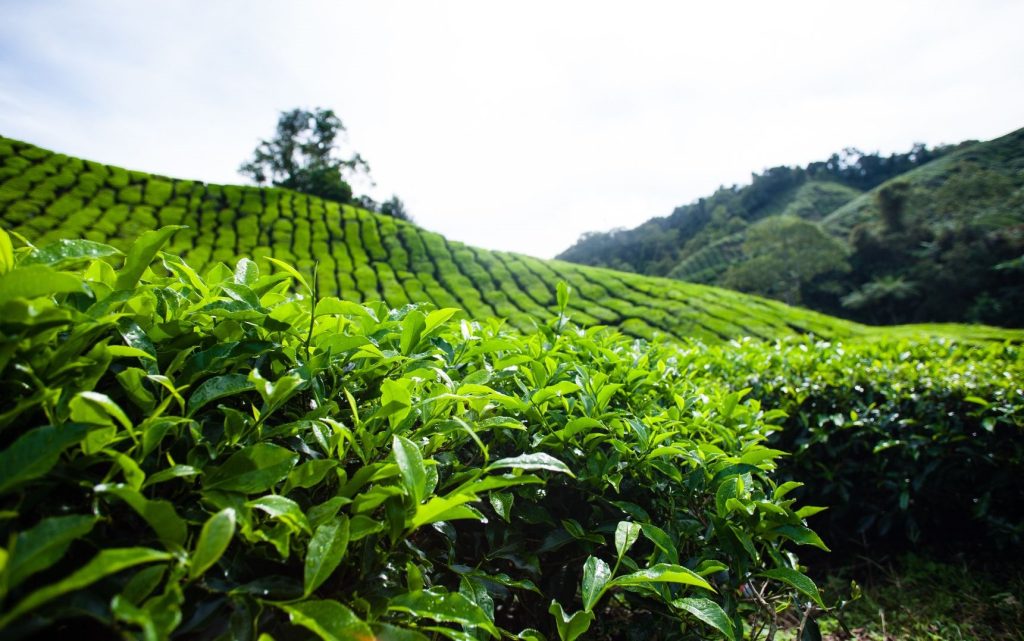
Sowing methods for tea crop
Sowing methods include:
- spot (or dot) sowing,
- strip sowing, and
- broadcast sowing
Of the 3 sowing methods, spot sowing and strip sowing are the most commonly used for tea.
Dot sowing: row spacing 20 cm, hole spacing 15 cm, each hole sowing 5-6 seeds.
Strip sowing: It can be single strip sowing or wide strip sowing, single strip sowing row spacing 15-20 cm, wide strip sowing row spacing 20-25 cm, sowing width 5-10 cm, grain spacing of about 1 cm.
Broadcast sowing: It is about scattering the tea seeds evenly on the seedbed.
Various sowing methods are appropriate to cover 36 cm after sowing, winter sowing, sandy soil should be deep. For spring sowing, clay soil should be shallow to facilitate seedlings’ emergence.
After sowing in the seedbed and covering it evenly with a layer of 5–10 cm thick hay, wood chips, or grain hulls, and other mulch to retain water and heat, prevent the growth of weeds, and facilitate the emergence of seedlings, the conditions can also be used to cover the ground film (6).
Propagation of tea cuttings
Selection of spikes and spike-cutting techniques
The best choice of a spike is full of axillary buds, leaves intact, robust growth, and no insect damage to the current year’s semi-woody mature branches. Spike cutting time is best in the early morning when the water content of the branches is high and conducive to cutting spikes and cuttings. The cut spike standard is a complete node, leaves, and axillary buds on each spike. The spike is generally 3-5 cm long. The cut of the spike must be tilted in a horseshoe shape, requiring a smooth cut, not a cracked one with injury.
Handling of short spikes
Cuttings can usually be used without any treatment. But in order to make its wound heal as soon as possible and improve the survival rate, the cuttings should be immersed in a mixture of 40 mg/l 2, 4-D, 50 mg/l naphthoacetic acids, and indolebutyric acid of the same concentration for 12-24 hours after cutting. During this period, it is necessary to pay attention to strict control of the concentration of agents and impregnation time. If the concentration is too large and the impregnation time is too long, it will affect the survival of root development and even cause the xylem of cuttings to separate from the whole cortex.
When is the best time to take tea cuttings
Tea tree cuttings can generally be taken in the spring, summer, and autumn. In subtropical regions, cuttings are obtained in September–November and transplanted in June–July of the following year for the best growth of tea trees.
Cuttings method
Water the seedbed or nutrient bag thoroughly, and let the soil be fully moistened before taking the cuttings. The spacing of cuttings should be determined by the size of the leaves of the tea species. Generally, a distance of 8–10 cm between rows and about 3 cm between plants is used so that the leaves meet and do not overlap. Insert the spike gently into the soil, into the soil depth of about 2/3 of the spike length, so that the leaves and petioles are exposed to the ground, not close to the ground, so as not to stain the leaves and fall off. Immediately after the insertion, the plant needs to be watered and covered with shade (6).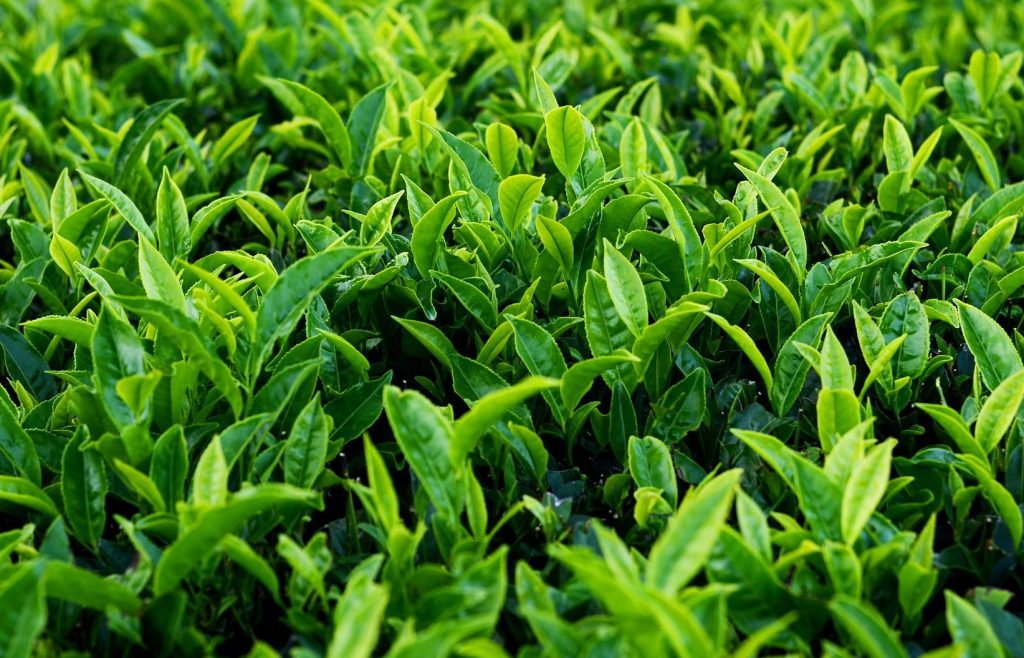
Tea plantation fertilization – Nutrient needs of tea plants
After a few times a year of picking, tea production removes large amounts of nutrients from the soil, breaking the original soil balance. To make the new plant tips strong and ensure continuous growth, there should be a constant supply of necessary nutrients for tea crops to meet new growth needs.
Tea farmers know that to obtain a good yield of tea leaves, there is a need for additional fertilization. However, during this activity, there is a general phenomenon of less organic and more chemical fertilizers. At the same time, fewer phosphorus and potassium fertilizers are used compared to nitrogen fertilizers. The mass application of inorganic nitrogen fertilizer mainly affects the quality of tea leaves, with the new tips having a green to dark green color instead of the ideal light green or yellow-green. The final processed product is inevitably bitter, heavy on the astringent taste, and has a low aroma. Stout tea stalks, long internodes, the continuous growth of new tips, and difficulty forming standing buds are other “side-effects” of the overuse of nitrogen fertilizers in a tea plantation. As a result, the quality of tea decreases, and the economic benefits are poor.
Reasonable fertilization should master the following principles:
1) The fertilization should consist of a combination of organic and inorganic fertilizers. It is required that organic fertilizers be applied at least once a year in tea plantations. In each round/season, buds must sprout before the appropriate amount of inorganic compound fertilizer can be applied.
2) Application of nitrogen, phosphorus, and potassium with a specific application time and rate. In order to give full play to the good fertilization effect and further improve the quality of tea, only a reasonable proportion of fertilizer is formulated for different production of tea trees in different fertilizer demand periods. Specifically, it depends on the ratio of the three elements of fertilizer, with indicators for nitrogen, phosphorus, and potassium ratios of about 3:1:2 or 2:1:1. 3) The amount of fertilizer application should be based on the amount of tea production expected (and removed the previous year). The amount of fertilizer mainly depends on the fertilizer absorption rate. Fertilizer is applied to the tea plantation after the water loss to determine the situation. Generally, for every 20–30 kg of tea production, 2–3 kg of compound fertilizer can be applied to the soil (the ratio of nitrogen, phosphorus, and potassium in compound fertilizer is 2:1:1 or 3:1:2) (7).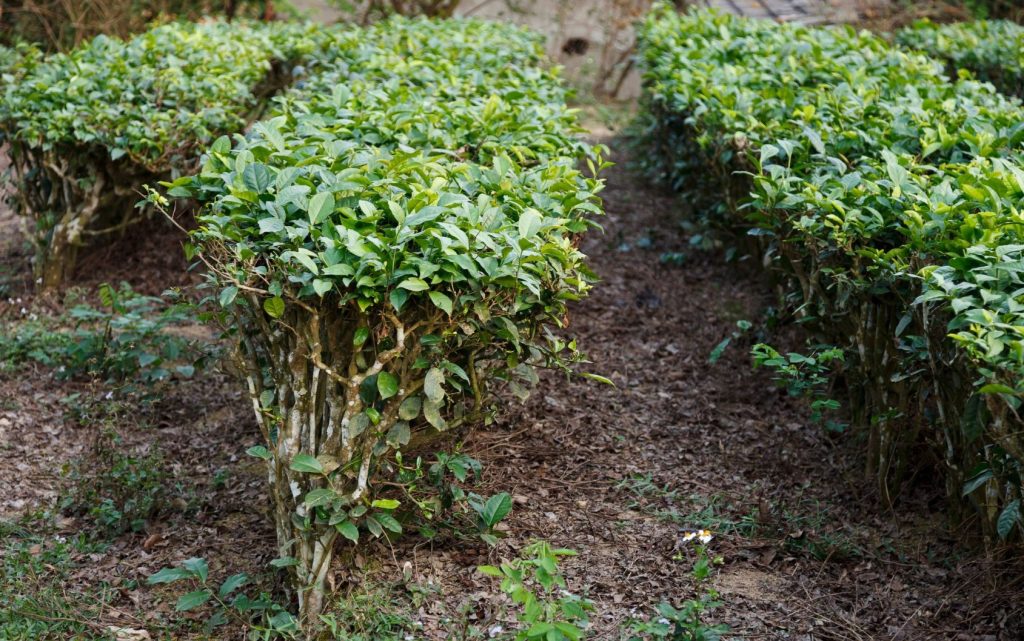
Disease and pest control of tea tree
The important disease of tea tree
Tea tree brown spot
Occurrence conditions: Tea tree brown spot is caused by Sporadic fungi (Exobasidium vexans). It occurs more commonly in tea plantations in high mountain tea areas. After the disease develops in tea plants, it produces poor growth and small buds and leaves, and the dry tea made from the diseased leaves has a bitter taste. Therefore, the disease has a greater impact on the yield and quality of tea. Low temperatures and high humidity favor disease development. These conditions are prevalent in the rainy seasons of spring and autumn.
Prevention and treatment methods: for the heavier incidence of tea plantations, it is best to spray a 0.6-0.7% lime half-measure Bordeaux solution in early spring, in February-March, for prevention.
Tea anthracnose
Occurrence conditions: Tea anthracnose is caused by Phyllosticta theaefolia. This disease is more severe in the rainy season, and autumn rains; the plantations under nitrogen overfertilization are susceptible to the disease. The symptoms and spread of the disease occur more in the rainy seasons of spring and autumn. Generally, this disease occurs in the years of newly grown leaves. The disease will cause extensive leave drop leading to tree weakness and yield reduction.
Prevention and treatment methods: In autumn and winter, proper cleaning should be done to remove the diseased leaves on the ground and the diseased leaves from the trees. The best time to start spraying appropriate fungicides on new shoots is after the end of the summer dry spell or the beginning of autumn rains.
Tea leaf blight
Occurrence conditions: Tea leaf blight is mainly caused by Colletotrichum gloeosporoides. The disease mainly affects leaves, shoots, branches and fruits of the plant. After the tea plant is infected with the disease, its leaves often fall off early, and the phenomenon of dead shoots occurs, which leads to the weakening of the growth of the tea plant.
Prevention and treatment methods: Accurately and effectively controlling black spiny whiteflies, tea aphids, and other pests is the fundamental measure to prevent and control the disease. Spray a 1% Bordeaux solution of lime in early spring to prevent disease spread.
The important and common pest of tea tree
Tea tarsonemid mite (Polyphagotarsonemus latus)
Symptoms: This pest mainly inhabits the young shoots and the back of leaves of tea plants with adult mites and wakame mites, sucking the sap from them and damaging the plant. When the leaves are damaged, the backs will appear rusty and harden and thicken; the leaf tips will be twisted and deformed; and the buds and leaves will shrink.
Control method: After the harvest of autumn tea (which can be picked in batches multiple times), spray Boehmer 0.5-degree staphylococcus on the leaves before late November to reduce the number of overwintering insects. Before the peak of insect infestation, spray with 20% pyridaben or 15% mirex and 25% pendimethalin on the leaves.
Tea aphid (Toxoptera aurantia)
Symptoms: This pest mostly gathers on the back of the leaves of the new shoots and is often found in the first and second leaves under the shoots. It will pierce the tissues of the young leaves with its oral needle and feed. This activity will cause the shoots and leaves to shrink and stop elongating. In some cases, the infested shoots will die. The excretion of this pest, “honeydew,” will also contaminate the shoot tips and further cause coal disease.
Control method: Harvest tea leaves in batches of multiple picking. And spray 40% leucovorin, 50% octreotide, and 80% dichlorvos on the back of the leaves (7,8).
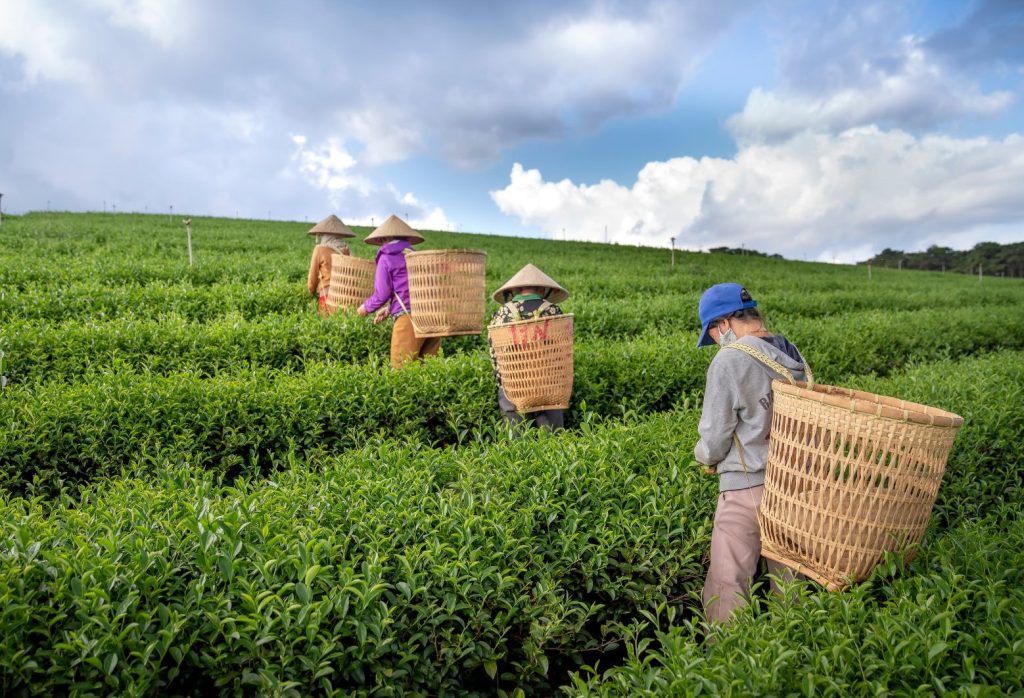
Tea picking methods and tips
There are three methods of picking tea: hand picking, harvesting with a special knife, and machine harvesting (8).
- Hand picking method is the most commonly used method of harvesting tea at present, which is especially suitable for making high-quality tea. It has the advantages of avoiding heat and pressure on the tips of the hand, and the quality of the fresh leaves is more consistent. Hand-picking was born out of long practice, usually with the thumb and forefinger slightly twisting the bud tip’s top center upward gently and picking the bud tip.
- In the knife-picking method arch-cutting knives are usually used.
- The machine picking method is to cut off the bud tips with a tea picker (8).
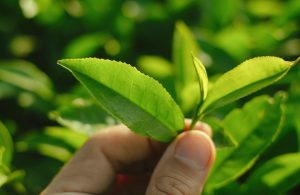
The quality of fresh leaves picked by the latter two methods was significantly worse than those picked by hand. However, if the operation is skilled and the fertilizer and water management are applied appropriately, the mechanical tea picking will have little impact on the growth and development of tea trees and the yield and quality of tea. At the same time, this harvesting method can reduce the labor force needed, reducing production costs and improving economic benefits (8).
“No stem, no old leaves, no missing leaves” should be collected when picking. It is necessary to separate mechanical picking from hand-picked tea leaves, tea leaves of different tea tree varieties, tea leaves picked on sunny days from those picked on rainy days, normal tea leaves from damaged leaves, mature leaves from old leaves, and tea leaves harvested in the morning from those harvested in the afternoon. Only by adhering to this practice can we make high-quality tea (8).
During the picking process, to prevent the fresh leaves from going bad, attention should be paid to:
- Keep the buds and leaves intact, and do not pinch them too much. It is necessary to put the collected tea leaves in the basket and not press them to avoid damage or increase their temperature.
- The harvested fresh leaves should be placed in the shade.
- Picking containers should be cleaned regularly and kept breathable and odorless. And in the process of transportation, fresh tea cannot be stacked too much to avoid high pressure on the bottom of the tea caused by damage (9, 10).
Tea processing
Tea processing, also known as “tea making”. It is the process of making semi-finished or finished tea from fresh tea leaves through various processing procedures. The different processing processes can be divided into primary (primary processing), refining (fine processing), reprocessing, and deep processing. Other processing technology will form different kinds of tea, and the formation of tea quality depends on the coordination of the processing process; High-quality fresh-leaf raw materials can only be produced under excellent processing conditions to produce high-quality tea of all kinds (9).

Figure 2. Six basic tea processing processes (11)
Reference:
(1). 姚美芹主编.茶树栽培技术.昆明: 云南大学出版社, 2015.03:1-3
(2). Trevisanato S I, Kim Y I. Tea and health[J]. Nutrition reviews, 2000, 58(1): 1-10.
(3). FAO (Food and Agriculture Organization), Detailed trade matrix, 2019. http://www.fao.org/faostat/en/#data/TM
(4). 陈炳环 .茶树品种分类的探讨: 中国茶叶, 1988:4-5
(5). Pan S Y, Nie Q, Tai H C, et al. Tea and tea drinking: China’s outstanding contributions to the mankind[J]. Chinese Medicine, 2022, 17(1): 1-40.
(6). 于龙凤编. 茶树栽培技术. 重庆: 重庆大学出版社, 2013.06:4
(7). 姚美芹主编. 茶树栽培技术.昆明:云南大学出版社,2015.03:50-68
(8). 温云林. 名优茶栽培田间管理技术[J]. 现代农业科技, 2018, (17):54-55,57.
(9). 尹在继,裘览耕. 论茶叶分类[J]. 茶叶. 1986(01)
(10). 陈霖. 金绿香[J]. 茶叶科学技术. 1996(04)
(11). https://www.riyang-teayard.com/riyang-tea-classificationen/



















